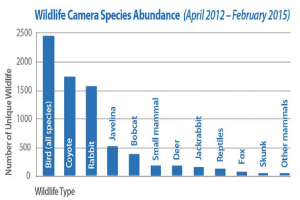
Oracle Road myth-based animal bridge closer to reality
Soon brilliant animals will have a safe route to cross Oracle Road, but first motorists are advised to be aware of an upcoming traffic switch that will in place by Friday, August 7, between Oro Valley and Catalina.
The $33.9 million improvement project, which started in June 2014 and is more than halfway completed, includes an animal bridge.
Beginning at 5 a.m. on August 7, all SR 77 traffic between Wilds Road and Rancho Vistoso Boulevard will be re-routed to the newly completed southbound lanes through the end of the year so crews can begin work on adding capacity to the northbound lanes. Both directions of traffic have been traveling on the northbound lanes since early this year as crews worked on improvements to the southbound lanes.
Along with the animal bridge, the road will be widened, medians will be raised, and sound walls will be erected. The widening of Oracle Road will also tie into the recently widened section of the highway from Calle Concordia to Tangerine Road.
ADOT remains on schedule to complete the project by spring 2016.
The animal bridge is funded by the taxpayers of Pima County who voted “yes” in the $2.1 billion 2006 Pima County Regional Transportation Authority (RTA) election.
According to the Pima County Wildlife Connectivity Assessment: Report on Stakeholder Input, dated February, 2012:
As part of that approval, county voters specifically ear-marked $45 million to be used to incorporate wildlife linkage conservation into transportation projects. Over the 20-year timeframe of the RTA, these funds will mitigate barriers to wildlife movement and reduce wildlife-vehicle collisions.
However, in an article in Slate.com, What Animals Don’t Need, by Fred Pearce notes that “Paul Beier, a veteran conservation biologist from North Arizona University at Flagstaff, and his colleague Andrew Gregory, warned that “despite much research, there is little evidence that conservation corridors work as intended.”
In his article, that originally appeared in New Scientist, Pearce notes:
“Other studies have shown that conservation corridors work. But most have looked at short corridors of 100 meters or so through largely natural landscape. “Just because species can use and travel along short corridors in a natural setting does not mean that they will be successful dispersing along much longer corridors embedded in a large, heavily impacted landscape,” says Gregory. “
Surely any corridor is better than none? But consider this. The edges of wild areas are known danger zones for wildlife, where predators and diseases may invade. Linking two existing protected areas with a long narrow corridor may expose it to greater danger along these edges. Unless the benefit exceeds the threat, then there is serious potential to do harm.
Pearce concludes, “Gregory and Beier do not dismiss corridors altogether. They believe they can still work, if designed properly. The problem is, we don’t really know what that means.”
 According to a group of animal bridge supporters’ own data, the need for the bridges is questionable. Between April 2012 and February 2015, their wildlife cameras captured mostly bird activity.
According to a group of animal bridge supporters’ own data, the need for the bridges is questionable. Between April 2012 and February 2015, their wildlife cameras captured mostly bird activity.
Related article: Millions Spent for Oracle Road Wildlife Crossing
